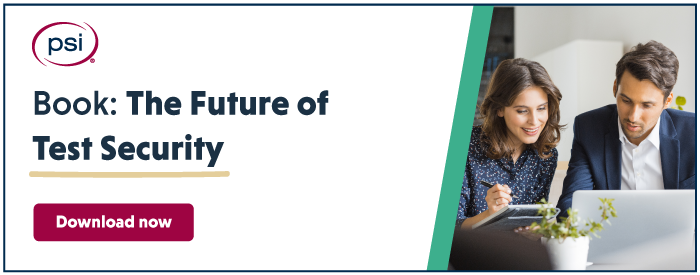With the impact of COVID-19, higher education institutions and its students found themselves rushed into online proctoring situations. Now that we’re moving toward a post-COVID world, or at least a time in which we have adjusted to living and working with COVID regulations and restrictions, it’s critical to reflect on how needs were addressed, what worked well and what didn’t, and how we can improve upon online proctoring strategies for the future.
The Impact of COVID-19
The onset of the pandemic this past spring left many institutions scrambling to move to online proctoring as states shut down in order to manage the spread of the virus. Schools have closed, limiting the ability to continue with in-person testing.
 As a result, institutions were left with a stark decision, move testing online or stop testing altogether. However, students needed to take exams, so the former was adopted by the masses.
As a result, institutions were left with a stark decision, move testing online or stop testing altogether. However, students needed to take exams, so the former was adopted by the masses.
As institutions began converting to online proctoring, an interesting dialogue from detractors emerged with questions and comments like, “How are students safeguarded?” “It’s not a level playing field,” “It’s not comparable to on-site testing,” and “It doesn’t stop cheating.” From the perspectives of students, similar concerns emerged such as: “How is my data being used?” “Why don’t I have a choice?” “It’s creepy,” “Why do you need online access?” “It’s invasive,” as well as others.
Although these are valid, many of these concerns and questions were a result of the rush to online proctoring and could have been minimized — if not completely alleviated — through an effective articulation of the process and an explanation of how the proctoring would be administered.
Read more about how to make online testing less "creepy."
Below, I address the key components of online proctoring and discuss how they address these concerns so you can separate the hype from the reality of online proctoring.
The Case for Online Proctoring
An online proctoring platform should authenticate a student’s identity and protect against proxy testing, as you would in an in-person setting, by capturing a valid ID and comparing it with a photo selfie.
Online proctoring offers convenience and availability for the student, and — if done properly — should also be easier to both administer and take as opposed to all the operational elements that go into scheduling and securing an exam at a physical location. However, with online proctoring, the student is responsible to show that their testing environment meets the standards and requirements set by the school. This includes the students recording or showing their testing environment for proctor validation prior to taking the exam.
With regard to preventing or detecting cheating, we recommend using a lockdown browser to prevent access to unauthorized digital resources, and recording the entire exam session via the webcam, thus enabling the proctor to monitor the student’s activity as they’re taking the exam. Lockdown security, real-time recording, and constant monitoring should provide the same security as an on-site environment.
Best Practices in Online Proctoring
-
Explain the Process. Communication is key. It is vital for the proctoring provider to share as much about the online proctoring process as possible. Walk-through videos or instructions with screenshots provide a great way (pre-exam) to get students comfortable with what to expect. Also, providing assurances that online proctoring systems have students' security and privacy held in high regard — where recordings and other monitoring processes are limited to the online proctoring application and are removed post-exam — is important.
-
Build Familiarity with the Process. Provide opportunities for a practice exam. This way, students will be familiar with what the live exam will look like. They will be able to experience the system that will be used, understand how that system will look on their machine, provide appropriate familiarity with the process, and minimize exam-day technical issues.
-
Capture Informed Consent. Provide information about the process, articulate what data is captured for what purpose and for how long, and then have the student sign off on it. This way they will not only have experienced it through a practice exam, but they will also be reminded of what to expect when they take the exam.
-
Ensure Access to a Necessary Test Environment. Exam sponsors should provide a process in which students can provide notice if they do not have access to an appropriate test environment, so alternative arrangements can be made in a timely manner. It’s important to ensure sufficient accommodations, whether it be hardware, software, or the physical location at which an exam will be taken. An online proctored exam requires that the student provide the necessary equipment and setting to meet the test-sponsor needs as well as the individual needs of a student.
Related: 6 Things You Should Know About Online Proctoring And LMS Integration
The Role of AI and the Human Proctor
There now exists a variety of online proctoring modalities. One is where a live proctor monitors a student online as they take an exam (live proctoring). Utilizing this method over time can become labor intensive and expensive. By integrating AI technology, online proctoring can become more efficient. Similar to using a fingerprint or facial detection login with your cell phone, AI technology in online proctoring can be used for ID validation. AI can also assist in flagging suspicious behavior when a student is taking an exam, such as changes in lighting or repetitive movement that may indicate a student looking at unauthorized material.
With the onset of COVID-19 and the impact of the pandemic, we have noted an overreliance on AI in online proctoring. Many institutions quickly adopted AI in online proctoring in order to implement the lowest-cost solution. However, although AI is efficient in flagging behavior, those flags are not always indicative of integrity violations. For example, AI during an online exam may flag a student for having a conversation when taking an exam and may note it as potential cheating. But if a child comes in to ask for a drink, that might not be considered cheating if reviewed by a proctor, either live or after the fact. Above all, it’s absolutely critical that you clearly articulate to your students how AI will be used in your process. If AI flags are not going to be later reviewed by a human proctor, students should understand what behavior is being monitored. Computer-generated messages during the exam can provide vital information to the student about how their own behavior is impacting the AI-proctoring. Some physical or mental conditions produce behavior flagged by AI. In those situations, AI alone should not be the judge and jury. Although online testing is critical and expands availability — especially in the world we live in today— the human proctor is still important and should be factored into any exam process. As such, quality in your proctors is of the utmost importance.
At PSI, proctors engage in a rigorous training program, receive certifications, and go through regular audits to ensure that they maintain high standards. The goal of the human proctor is to not only explain their role to the student, but to also show empathy and understanding as well as professionalism. In a high-stakes exam, AI can improve efficiency and reduce cost, but a well-trained, professional human proctor is still necessary to fully ensure a fair exam experience.
Data and Privacy
When focusing on data privacy rights and protection, we recommend focusing on three primary questions:
-
What data needs to be collected? For example, if the current student has already been verified and authenticated in a previous system, it might not be necessary to validate their ID on exam day.
-
Does the proctoring method offer data and privacy protection? With a secure or lockdown browser, there should not be a need for remote access. Remote access creates risk to student and corporate data when the student is on a computer connected to the organization’s network.
-
How does the online proctoring platform store the data collected and for how long? Be sure to confirm that the data collected is only used to protect the integrity of the exam experience. Then be sure to communicate that to your students.
COVID-19 has certainly created challenges and changes in the education space. Online proctoring usage has increased, and it's here to stay. The most important lesson we’ve learned throughout this transition is that we must put the student at the heart of the process. So, it’s important to keep the student a priority as your online proctoring process evolves.


 Douglas M. Winneg is the Executive Vice President, PSI Services LLC. Doug has worked in the Academic and Certification Assessment space for 18 years. Both as head of the PSI Services Education group, and prior to that as CEO and founder of Software Secure, acquired by PSI in 2016, Doug has designed assessment systems and services with a single objective, to promote test integrity. As CEO of Software Secure, he was the designer of the company’s patented Securexam Lockdown technology and Remote Proctor products.
Doug has lead the design of secure computer-based testing systems for higher education and K-12 online education programs and national certification providers in the United States, Canada, The Netherlands and The United Kingdom, Australia and South Africa.
Doug received his J.D. from the Benjamin N. Cardozo School of Law, and a Bachelor of Arts with Honors from Swarthmore College.
Douglas M. Winneg is the Executive Vice President, PSI Services LLC. Doug has worked in the Academic and Certification Assessment space for 18 years. Both as head of the PSI Services Education group, and prior to that as CEO and founder of Software Secure, acquired by PSI in 2016, Doug has designed assessment systems and services with a single objective, to promote test integrity. As CEO of Software Secure, he was the designer of the company’s patented Securexam Lockdown technology and Remote Proctor products.
Doug has lead the design of secure computer-based testing systems for higher education and K-12 online education programs and national certification providers in the United States, Canada, The Netherlands and The United Kingdom, Australia and South Africa.
Doug received his J.D. from the Benjamin N. Cardozo School of Law, and a Bachelor of Arts with Honors from Swarthmore College.